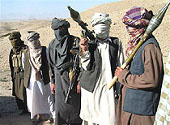Fighting the "War on Terror" Backwards
 The struggle in Afghanistan continues into its eighth year with no end in sight. The United States is continuing to dump resources into a region that has been effectively abandoned by al Qaeda. So where has al Qaeda gone? Pakistan of course! This is a great strategy on the part of the al Qaeda - flee to a country that the U.S. cannot legally enter.
The struggle in Afghanistan continues into its eighth year with no end in sight. The United States is continuing to dump resources into a region that has been effectively abandoned by al Qaeda. So where has al Qaeda gone? Pakistan of course! This is a great strategy on the part of the al Qaeda - flee to a country that the U.S. cannot legally enter.
However, The Administration has chosen to focus on Afghanistan as the central front in the United States' Overseas Contingency Operations (the conflict formerly known as the War on Terror, of course). Here's why this decision doesn't make sense: Foreign Policy magazine puts it mildy when saying, "In effect, the United States is undertaking a $65-billion-a-year campaign in Afghanistan to defeat an enemy that is, for the most part, located across the border."
The goal in Afghanistan has shifted from "fighting the enemy" toward "nation building." However, according to the Foreign Policy article, this may not be at all feasible:
Today's Army mission statement for Afghanistan says "killing the enemy is secondary" to the larger goal of "protecting the populace." Preventing a return of al Qaeda to Afghanistan is important, but a long, state-building mission in one of the world's most underdeveloped countries is the costliest and least effective way to accomplish that goal.
If, that is, it is accomplishable at all. Building up the Afghan government to serve as a credible presence throughout the country will be an extraordinarily difficult mission. Corruption is rampant, and the Afghan Army and police are unable to provide any significant assistance to the counterinsurgency mission. After eight years, the face of the war in Afghanistan is that of a U.S. soldier, and it will likely remain so for the foreseeable future.
The Economist magazine supports this analysis of the situation in a feature article last week titled "Into Taliban Country":
Theorists of counter-insurgency say that fighting guerrillas requires time and patience (and even more foreign and local soldiers than are available in Afghanistan).
So what is the solution? Perhaps the answer lies in focusing on the one place where the Taliban leadership actually is - Pakistan!
The even better course of action is to shift the weight of U.S. political and military efforts to Pakistan. There, the United States should continue its policy of waging drone attacks against al Qaeda and Taliban leaders. With better intelligence from the Pakistani side -- as demonstrated recently -- the U.S. Army can improve the accuracy of its strikes. And though drone strikes are controversial, targeting al Qaeda's leadership is the best military strategy -- and the best way to protect Americans, Afghans, and Pakistanis from terrorism. And that fight is in Pakistan, not Afghanistan.
Of course, we're talking about waging a war IN Pakistan, not a war AGAINST Pakistan. We're talking about cooperation with an existing democratic government. In Pakistan the U.S. stands a much better prospect of permanantly fracturing al Qaeda and creating regional stability. Pakistan already has an infrastructure in place that can be adapted and scaled to promote stable democratic governments and effective military and police forces throughout the region - neither the prospect of a stable governement or an effective military are in Afghanistan's forseeable future. As the Foreign Policy article concludes "The sooner the United States realizes that the better."



